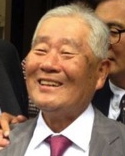 Han Tak Lee (Photo by Dong Chan Shin/Korea Daily)
A week later, Monroe County Sheriff’s deputies arrested the woman’s father, 54-year-old Han Tak Lee, and charged him with first-degree murder and arson. The police said that arson investigators concluded the fire was deliberately set and that Lee made inconsistent statements about his efforts to rescue his daughter.
Lee went to trial in the Monroe County Court of Common Pleas in September 1990.
The prosecution called three witnesses to testify about the fire: Daniel Aston, an expert origins and causes of fires; Pennsylvania State Trooper Thomas Jones, the investigating fire marshal; and Pennsylvania State police crime lab chemist Thomas Pacewicz, who performed analysis of debris for accelerants.
The witnesses testified that the fire burned so fast and at such an extraordinarily high temperature that it could only have been caused by the intentional use of accelerants. One ignition point was identified by the presence of crazed glass—a network of thin cracks in glass that arson investigators believed were caused by a very hot fire. They testified that the furniture springs and bedsprings had collapsed, another supposed indicator of an extremely hot fire. The chemical analysis, according to the testimony, showed the presence of fuel oil plus another unidentified accelerant such as gasoline.
The defense attorney had consulted an arson expert prior to trial, but decided not to call him as a witness. He did so because the expert—who concluded that the fire appeared to be accident—could not identify the actual cause of the fire. So the defense argued that Lee’s daughter, who was suffering from depression and had been heard saying that the cabin would be her “tomb,” set the fire herself to commit suicide.
Lee, a South Korean immigrant who was a U.S. citizen, ran a clothing store in Manhattan and lived with his wife and another daughter in Queens. He testified in his defense that members of their church suggested that he take his daughter to Camp Hebron to pray and meditate.
When the fire broke out at 3 a.m., Lee said he left the cabin after smelling smoke and hearing electrical wires burning. When he realized Ji Yun was still inside, he went back inside, but could not find her and fled because the flames and smoke were too intense. Her body was found near a bathroom where the roof collapsed during the fire.
On September 17, 1990, the jury convicted Lee of first-degree murder and arson. He was sentenced to life in prison without parole.
Lee appealed, and the case was remanded for a hearing on a motion to vacate the conviction on the ground that Lee’s trial attorney had failed to call a fire expert to testify. The motion was supported by an affidavit from arson expert John Lentini that stated that the prosecution’s witnesses had relied upon outdated fire science to conclude that the blaze was arson. The motion was denied and the convictions and sentence were upheld on appeal.
In 1995, Lee filed a hand-written motion for a new trial. The prosecution was ordered by the judge to respond but never did so. Ultimately, in 2001, Lee, represented by attorney Peter Goldberger, filed an amended motion for a new trial based on Lentini’s analysis that the fire was an accident rather than arson. The motion sought the prosecution’s crime lab reports and underlying data. The Monroe County District Attorney’s Office did not oppose the motion but the judge denied it, saying that production of the materials would be “unduly burdensome” on the Pennsylvania State Police.
After another amended petition for a new trial was filed in 2005 and again denied, Lee filed a federal petition for a writ of habeas corpus in 2008.
Lentini submitted a 46-page affidavit that systematically discredited the prosecution’s arson evidence as outdated, unfounded or erroneous.
For example, Lentini explained, the “crazed glass” that the prosecution’s witness cited as evidence of an ignition point is typically caused by rapid cooling of hot glass—frequently after it is sprayed with water by firefighters trying to extinguish the blaze—and has no value in determining whether a fire was caused by arson.
Lentini concluded, “I can state unequivocally that all of the evidence presented to the Court (at trial) by the Commonwealth’s experts is consistent with an accidental fire. Using today’s standards, there is no credible evidence that would lead a competent investigator to conclude that the fire was intentionally set.”
U.S. District Court Judge Malcom Muir denied the petition without a hearing, but in 2011, the U.S. Court of Appeals for the Third Circuit reversed that decision and ordered a hearing.
In June 2014, following a hearing, U.S. Magistrate Martin Carlson recommended that the petition be granted. “Today, with the benefit of extraordinary progress in human knowledge regarding fire science over the past two decades it is now uncontested that this fire science evidence — which was a critical component in the quantum of proof that led to Lee's conviction — is invalid, and that much of what was presented to Lee's jury as science is now conceded to be little more than superstition.”
On August 8, 2014, Judge William Nealon, to whom the case had been reassigned, officially granted the writ, vacated Lee’s convictions and ordered him to be retried within 120 days. Lee was released on bond pending retrial.
The prosecution appealed the ruling and on August 19, 2015, the Third Circuit Court of Appeals upheld the decision granting a new trial.
In November 2015, Monroe County District Attorney David Christine announced that he would not appeal to the U.S. Supreme Court because the chance of success was very slim. He also said there would be no retrial.
The 120-day period to retry Lee from the Third Circuit ruling in August expired on December 17, 2015.
In June 2021, Lee succombed to cancer.
– Maurice Possley
|